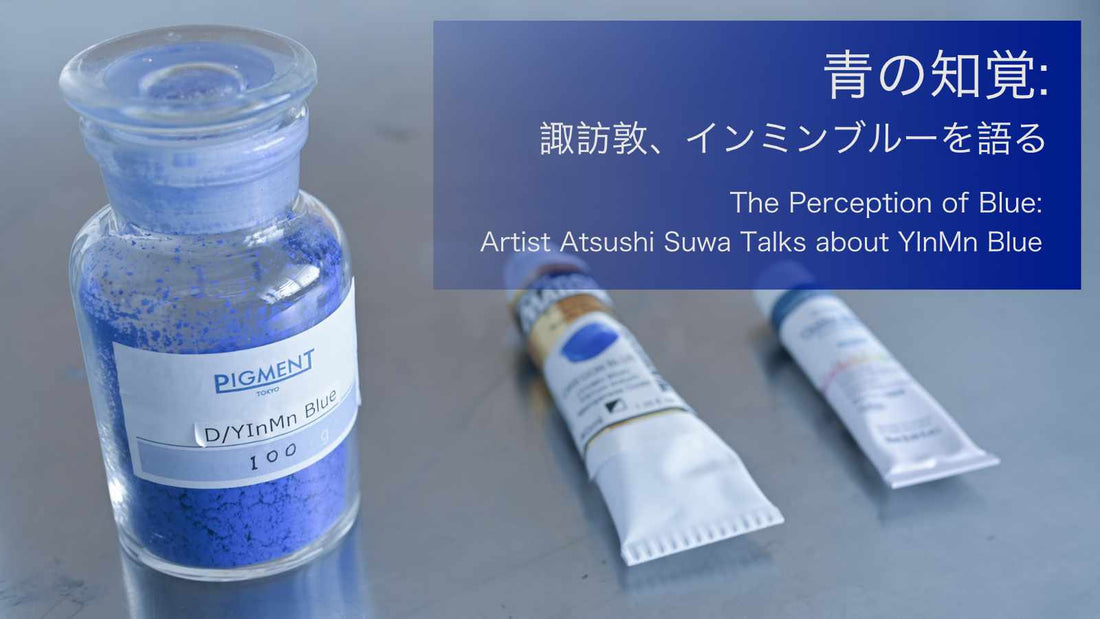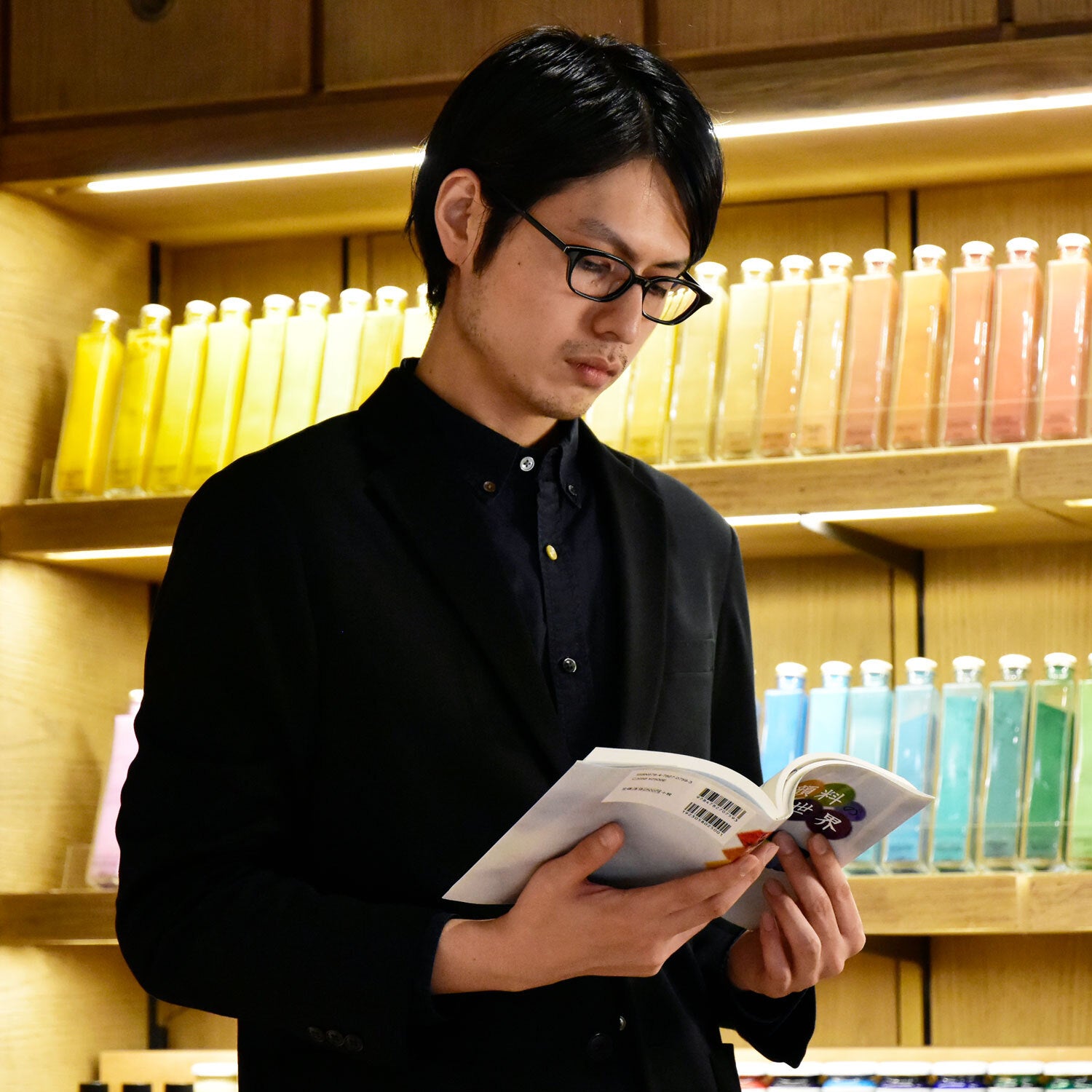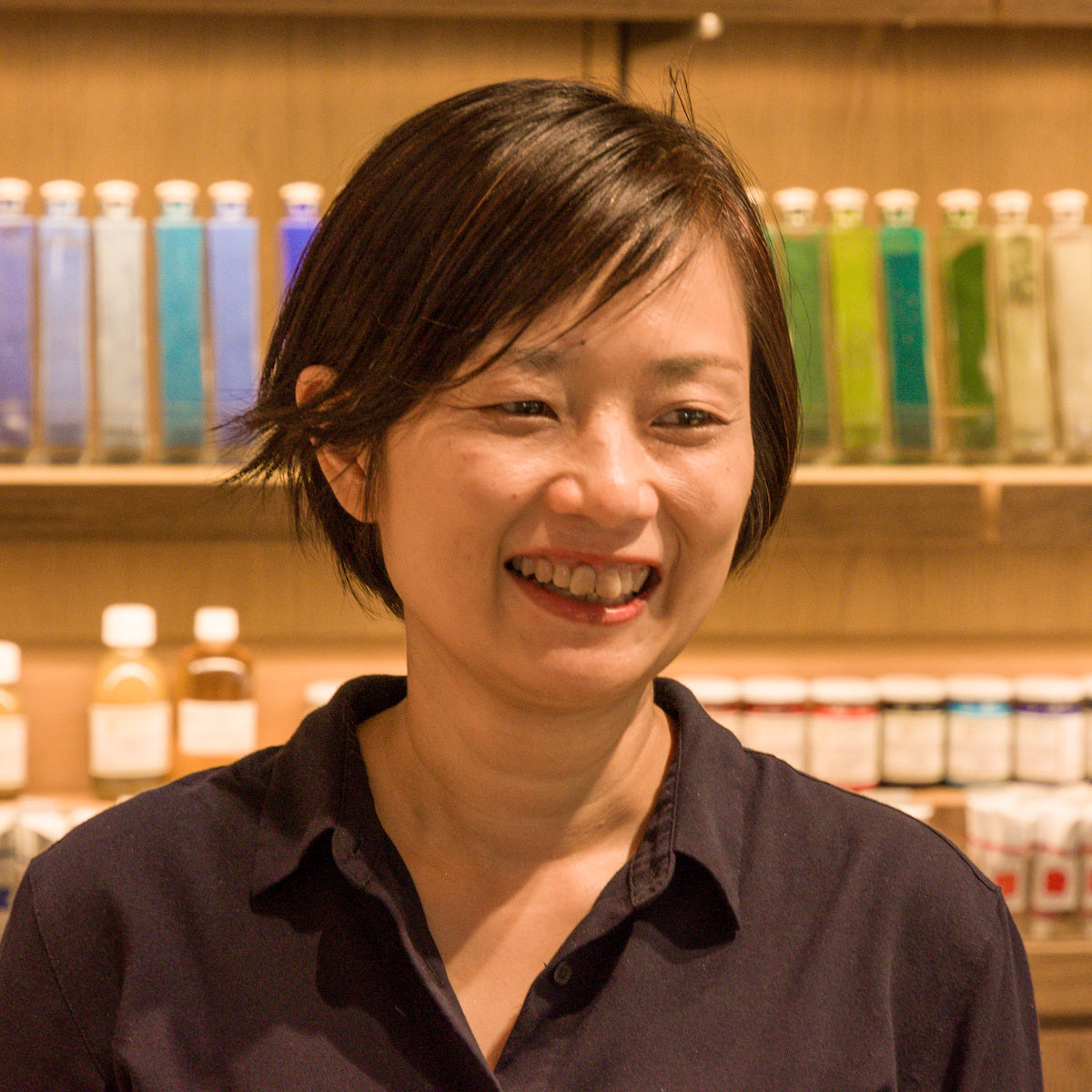YInMn Blue is an innovative artificial blue pigment that was accidentally discovered by a science team at Oregon State University while researching new raw materials for use in electrical systems.
The team found this pigment when they tested the manganese oxide and mixed it with other components at high temperatures.
Since 2018, PIGMENT TOKYO has been carrying YInMn Blue as an acrylic paint, pigment and oil paint. (*Sorry, YInMn Blue oil paint is no longer available.)
YInMn Blue ¥6,050 tax in
OREGON Blue (YInMn Blue) acrylic paints ¥18,700 tax in
PIGMENT TOKYO has provided the YInMn Blue as source material for Atsushi Suwa, a painter who explores art materials in contemporary uses with classical painting techniques.
In recent years, Atsushi Suwa has published an art collection book of his paintings titled "Blue, The Atsushi Suwa Paintings" (in 2017 by Seigensha Art Publishing, Inc.).
Therefore, I am very interested in how he felt and his experience with this brand-new blue.
Moreover, I would like to find out how he approaches his paintings based on his material research.
ーWhen did you first become aware of the importance of materials in your art practice?
Atsushi Suwa (hereafter Suwa / titles omitted): In the oil painting department at Musashino Art University, they have a painting material laboratory. Undergraduate students get to learn tempera paint techniques and mixed techniques with oil paint as mandatory courses.
I have been fascinated by tempera paint, which gives natural and delicate touches to the painted surfaces and can draw sharp lines effectively, so I have been using them in my personal projects since I was a graduate student. However, the use of the word "mixed technique" was a confusing term with a vague meaning and use at the time.
Meanwhile, maintaining the paintings that used tempera paint in a humid climate like Japan is very difficult, so I eventually stopped using it and not as much as I did in my paintings.
Even though I still think it has been an important experience for me to understand my paintings from the material aspect.
After completing my Master's, I joined the Program of Overseas Study launched by the Agency for Cultural Affairs as a researcher and studied abroad in Spain for two years in 1995. During that time, I spent a lot of time at the Prado Museum and studied Albrecht Dürer's paintings.
In European academies, replicating has traditionally been recognized as a method of mastering painting skills. The Prado Museum has easels in front of many masterpieces for art students and painters who make their living by creating replicas. I was impressed by the fact that the Prado Museum allows these paintings to be shown to the public and is open to giving a place for those who make replica paintings. This made me feel a strong sense of rich art culture.
However, the more I recognized the importance of painting techniques and materials, I also began to feel uncertainty about my obsession with them. I guess that was the time I started becoming more concerned about the importance of the sensation of manipulating paint and the physicality of drawing.
ー Do you remember your impression of YInMn Blue when you first saw it in person?
Suwa: Since I had heard the rumors of how it is “the perfect blue,” I had very high expectations of how blue it would be.
It was mentioned that YInMn Blue absorbs green and red radiation, so as a result, only blue appears distinctly, right?
I was curious to see the bottom, or rather the limit, of the perception of blue color, which means my desire to see how far we can perceive the color "blue."
To be honest, it was slightly darker than I thought and I did not expect to see a bit of redness in it.
Nevertheless, when I encounter such precious pigment, like secretly opening the present before Christmas, I cannot help but feel excited like a little boy.

A bottle of YInMn Blue pigment, an acrylic paint (DERIVAN) and a tube paint (Holbein)
ーPeople who love to paint have such appreciation for the materials, don't they?
Suwa: Definitely. For example, everyone gets attracted to pigments made from precious minerals.
The pigments derived from natural sources contain many impurities and the subtle differences caused by them are fascinating as well. However, the process which isn’t directly related to the quality of the materials can add value to them too.
As you can tell from my humble studio, I have no interest in displaying all the expensive mineral pigments. I am more likely to believe that even inexpensive painting materials and non-professional paints have their purpose too.

Several small motifs are placed in Atsushi Suwa’s simple and sophisticated studio.
ーWhat was your first impression after using the YInMn Blue pigment?
Suwa: The first thing that came to mind was, " who would necessarily need this?" because there are easier and cheaper options such as synthetic ultramarine blue that produce a similar color tone.
I couldn’t think of who’d want to choose such an expensive pigment with excellent weather resistance that is impossible for any human being to examine the changing condition of the pigment for such a long period.
However, it has a similar shade to Yves Klein's "International Klein Blue (IKB)." Perhaps if Yves Klein was still alive, he might have chosen YInMn Blue.
ーIKB has a slightly matte or subdued texture that seems to create depth in blue.
Suwa: When I added drying oil to the pigment, the color came out clearly blue even though it appears darker in powder, and I was fascinated by the cool hue that seems to be absorbing the light.
This artwork will be one of the main visuals for my next exhibition but can you tell which part is painted by YInMn Blue? Although I used three types of blue pigments, I think it’s quite easy to tell them apart.

“Mimesis” by Atsushi Suwa, 2022
259x162 cm, Oil on Canvas, Wood Panel
In the painting in this photo, I used a mixture of natural ultramarine and YInMn Blue to create the gradation in the blue strip on the left side of the skirt. You can clearly see the characteristics of YInMn Blue on the blue marks of the arms that blend into the background on the left side; the dark, rich blue like a deep ocean shown in the gap where the white paint is flowing in the center of the skirt. These are where I painted YInMn Blue on its own.
ーI see. We use the appropriate viscosity for tube paints in our products.
Suwa: Of course. Although if I adjusted the viscosity of the paint according to my preference, I could achieve the sensation drawn into its texture, which reminds me of the Klein Blue (IKB) we just talked about. Isn’t it amazing?
What makes YInMn Blue so special is that although it appears to have a darker tone in person, it can create a rich blue color.
I assume that I could also create a transparent optical illusion with this paint since it can absorb light to create an illusionistic feel.
As in black pigment like ivory black cannot cover up the underlayer with simply one brush stroke. It isn’t rich enough and tends to have more soft nuance.
The reason why such an extraordinary color was necessary is that this painting is objectively different from usual realist paintings.
ーWhat exactly do you mean by that?
Suwa: When I tune a radio late at night, I sometimes hear a mixed signal with a weird noise and unfamiliar languages, which might be a secret code from other countries *laughs*.
It feels strange as you may know like there is a sense of floating as if you are the solitude in the world.
I wanted to present this feeling in my paintings. I would say the colors that we see in the painting are somehow detached from human emotions.

When creating two paintings, Suwa said he creates this much of a blue-gray palette.
ーOh I see! So this is how you painted these artworks.
Suwa: I have been painting a dancer whose name is Kazuo Ohno since 1999. He passed away in 2010 at the age of 104. According to the general definition of realist painting, it is impossible to paint him again, because he could no longer be my model.
However, in my case, I believe that as long as I have the will to keep on painting, I could extend the relationship between us like summoning a dead soul back to life, therefore, I'd do anything to make it possible.
In the case of "Mimesis," which I mentioned earlier, when I handed over the image of the absent dancer, I painted as if two-time axes were intersecting on a single pictorial space. For a depiction that is not a reproduction of nature, I needed a blue that could express a depth that would absorb us to another dimension.
ーWhat’s the process of this painting?
Suwa: I painted "Mimesis" to continue my relationship with Kazuo Ohno as a collaborative project with another performer, Takao Kawaguchi. He received the Minister of Education, Culture, Sports, Science and Technology's Art Encouragement Prize in 2021, and before that, he was well known for his performance "About Kazuo Ohno" which was a challenge to recreate Kazuo Ohno’s performance entirely.
When I first heard about this, I could not have wished for a better person to meet my requirements. The word "Mimesis" means imitation and in ancient Greek philosophy, it indicates the core of the creative arts. It was also an attempt to reconsider the act of a creator such as myself, for whom depicting “subjects is the language of expression”.
ーDo you often relate your materials and motifs to each other?
Suwa: To be honest, not really. I see myself as more of a passive person.
This time, thanks to PIGMENT TOKYO for offering me such an opportunity to use YInMN Blue, so I could expand my story and try to connect them with my painting. I didn't even know that I could have such a strong attachment to the "blue" that will relate to my art practice so much, therefore, it is more like giving a meaning afterwards to encounters with art materials that are not necessarily actively reached out from me.

“Solaris” by Atsushi Suwa, 2017-2021
91 x 60.7cm, Oil on Chalk Panel
ーThere is also a unique beauty of the artificial blue, isn't there?
Suwa: For example, this is Utagawa Kuniyoshi's “Tamakazura, Genji-Kumo-Ukiyo-e-Awase” print and there is a reason why I put my personal collection out on the wall whenever I invite someone to come over to my studio. The artist used "Bero-Ai (Berlin indigo/ Prussian blue) " in this artwork and the Japanese people in the Edo period were amazed by its vibrant color.
Bero-Ai has changed ukiyo-e ever since its importation in the 18th century. Until then, "blue" in Japan had been derived from dyes such as Hon-Ai (indigo blue) through fermented Date-Ai (Japanese indigo plant) or a light dye extracted from the Asiatic dayflowers.
Although these dyes were still able to produce transparent blues, their colors were very light and difficult to handle.
On the other hand, the Bero-Ai was popularized in Europe and imported to Japan through the Netherlands, then became actively used as a pigment for ukiyo-e woodblock prints.
140 years had passed since this exotic blue color was invented in 1704, this artwork remained beautiful and relevant even though it was printed at a time when the color was already well known.

“Tamakazura, Genji-Kumo-Ukiyo-e-Awase” hangs in Atsushi Suwa’s private studio.
The work was created by Utagawa Kuniyoshi in 1846.
ーIs it different in the Western world?
Suwa: You might have heard the well-known urban story of lapis lazuli around the Netherlands in the 17th century. The blue pigment had such a high price that it is almost comparable to gold which proved its high making cost. Lapis lazuli was able to maintain its value in the painting market, which later extended to middle-class citizens.
On the other hand, I assume that the color of the artificial pigment, Bero-Ai, was quite far from the beauty sense the Japanese people used to have back in the 18th century. Back then, people had been familiar with light colors derived from natural dyes and Bero-Ai was almost too high-saturated and vibrant. Even in the "Fugaku Sanjūrokkei (Thirty-six Views of Mount Fuji)" by Katsushika Hokusai, which is known for the frequent use of Bero-Ai painted with a combination of Bero-Ai and Hon-Ai also, we can see a variety of blues in the work of Utagawa Kuniyoshi, although the exact formulation is not known.
Perhaps, when the cost of YInMn Blue becomes lower and more widespread, various artists will probably find the best way to use it.
The blue color often appears in Suwa's artworks. His somehow cool yet aesthetically sophisticated gaze toward materials seems to be common with the paintings that he creates through delicate processes.
Atsushi Suwa’s solo show, “Fire in the Medial Orbito-Frontal Cortex” starting in December 2022 at the Fuchu Art Museum, Tokyo includes paintings using YInMn Blue which is introduced in this article.
We are so excited to experience the beauty of the latest synthetic blue in person at this exhibition!
Artist Profile

Atsushi Suwa painting Takao Kawaguchi at Kazuo Ohno Dance Studio on November 16, 2020.
Photograph by Sakiko Nomura
Atsushi Suwa / 諏訪敦
Painter, born in Hokkaido, Japan in 1967, lived in Madrid as an overseas scholar artist dispatched by the Agency for Cultural Affairs in 1994. After returning to Japan, he created a series of paintings of Kazuo Ohno, a Butoh dancer, and his son Yoshito Ohno. It was the beginning of a shift from realistic representation to a style that emphasizes the process of research.
He was featured in TV programs, NHK's "Sunday Museum of Art: Painting with Memory ~ A Painter Who Portrays the Deceased~" in 2011, and ETV's "Portrait of Forgotten People: Atsushi Suwa, Painter of Manchurian Refugees" in 2016. Suwa's thoroughness in creative processes became widely known.
In 2018, he became a professor of the Oil Painting Department at Musashino Art University.
The official catalogue "Atsushi Suwa 'Fire in the Medial Orbito-Frontal Cortex'" (Bijutsu Shuppan-sha, LTD) will be published in December 2022.
Exhibition Info
*This exhibition has ended.
December 17, 2022 (Sat.) - February 26, 2023 (Sun.)
*Closed: Mondays (open on Jan. 9), December 29 (Thu.) ~ January 3 (Tue.), January 10 (Tue.)
*Opening Hours: 10:00 a.m. - 5:00 p.m. (Last entry: 4:30 p.m.)
Admission: Adults 700 yen (560 yen) / High school and university students - 350 yen (280 yen) / Elementary and junior high school students 150 yen (120 yen)
*Prices in ( ) are for groups of 20 or more.
*Pre-school children and those with disability certificates are admitted free of charge.
*Elementary and junior high school students in Fuchu City are free with a "Fuchukko- Manabi-no-Passport".
*Permanent exhibition can be entered along with a special exhibition ticket.
Organizer: Fuchu Art Museum
Special Cooperation: Gallery Naruyama
Cooperation: NPO Dance Archives Initiative Azumaya
Profile
Art Materials Expert at PIGMENT TOKYO
AKIRA OYA
Born in 1989 in Tokyo. Master of Fine Art and Design at Nihon University College of Art. While working at PIGMENT TOKYO as an Art Materials Expert, he also continues his career as a visual artist.
Born in 1989 in Tokyo. Master of Fine Art and Design at Nihon University College of Art. While working at PIGMENT TOKYO as an Art Materials Expert, he also continues his career as a visual artist.
Art Materials Expert at PIGMENT TOKYO
NATSUKO SHIRAISHI
Art Materials Expert at PIGMENT TOKYO Graduated from the Textile Design at Tama Art University. While she works as an art material expert at PIGMENT, she also continues her career as an artist of original paper, Japanese paper and calligraphy.
Art Materials Expert at PIGMENT TOKYO Graduated from the Textile Design at Tama Art University. While she works as an art material expert at PIGMENT, she also continues her career as an artist of original paper, Japanese paper and calligraphy.












